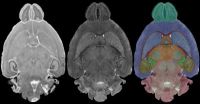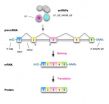(Press-News.org) ITHACA, N.Y. – The human hand is an amazing machine that can pick up, move and place objects easily, but for a robot, this "gripping" mechanism is a vexing challenge. Opting for simple elegance, researchers from Cornell University, University of Chicago and iRobot have bypassed traditional designs based around the human hand and fingers, and created a versatile gripper using everyday ground coffee and a latex party balloon.
They call it a universal gripper, as it conforms to the object it's grabbing rather than being designed for particular objects, said Hod Lipson, Cornell associate professor of mechanical engineering and computer science. The research is a collaboration between the groups of Lipson, Heinrich Jaeger at the University of Chicago, and Chris Jones at iRobot Corp. It is published today (Oct. 25) online in Proceedings of the National Academy of Sciences.
"This is one of the closest things we've ever done that could be on the market tomorrow," Lipson said. He noted that the universality of the gripper makes future applications seemingly limitless, from the military using it to dismantle explosive devises or to move potentially dangerous objects, robotic arms in factories, on the feet of a robot that could walk on walls, or on prosthetic limbs.
Here's how it works: An everyday party balloon filled with ground coffee – any variety will do – is attached to a robotic arm. The coffee-filled balloon presses down and deforms around the desired object, and then a vacuum sucks the air out of the balloon, solidifying its grip. When the vacuum is released, the balloon becomes soft again, and the gripper lets go.
Jaeger said coffee is an example of a particulate material, which is characterized by large aggregates of individually solid particles.
Particulate materials have a so-called jamming transition, which turns their behavior from fluid-like to solid-like when the particles can no longer slide past each other.
This phenomenon is familiar to coffee drinkers familiar with vacuum-packed coffee, which is hard as a brick until the package is unsealed.
"The ground coffee grains are like lots of small gears," Lipson said. "When they are not pressed together they can roll over each other and flow.
When they are pressed together just a little bit, the teeth interlock, and they become solid."
Jaeger explains that the concept of a "jamming transition" provides a unified framework for understanding and predicting behavior in a wide range of disordered, amorphous materials. All of these materials can be driven into a 'glassy' state where they respond like a solid yet structurally resemble a liquid, and this includes many liquids, colloids, emulsions or foams, as well as particulate matter consisting of macroscopic grains.
"What is particularly neat with the gripper is that here we have a case where a new concept in basic science provided a fresh perspective in a very different area – robotics – and then opened the door to applications none of us had originally thought about," Jaeger said.
Eric Brown, a postdoctoral researcher, and Nick Rodenberg, a physics undergraduate, worked with Jaeger on characterizing the basic mechanisms that enable the gripping action.
Prototypes of the gripper were built and tested by Lipson and Cornell graduate student John Amend as well as at iRobot.
As for the right particulate material, anything that can jam will do in principle, and early prototypes involved rice, couscous and even ground- up tires. They settled on coffee because it's light but also jams well, Amend said. Sand did better on jamming but was prohibitively heavy. What sets the jamming-based gripper apart is its good performance with almost any object, including a raw egg or a coin – both notoriously difficult for traditional robotic grippers.
###
The project was supported by the Defense Advanced Research Projects Agency.
END
In scientific publishing, how much reuse of text is too much? Researchers at the Virginia Bioinformatics Institute at Virginia Tech and collaborators have shown that a computer-based text-searching tool is capable of unearthing questionable publication practices from thousands of full-text papers in the biomedical literature.
The first step in the process is to find out what is restated before zeroing in on who may have crossed an ethically unacceptable threshold. The findings, published in PLoS ONE, offer hope for curbing unethical scientific publication practice, ...
VIDEO:
This video contains more on the pediatric bone cancer preclinical study.
Click here for more information.
BOSTON - Researchers have identified an important signaling pathway that, when blocked, significantly decreases the spread of pediatric bone cancer.
In their study, researchers at The University of Texas MD Anderson Children's Cancer Hospital in Houston found that blocking the Notch pathway in mice decreased metastases in the lungs 15-fold. The results of ...
DURHAM, N.C. – The most detailed magnetic resonance images ever obtained of a mammalian brain are now available to researchers in a free, online atlas of an ultra-high-resolution mouse brain, thanks to work at the Duke Center for In Vivo Microscopy.
In a typical clinical MRI scan, each pixel in the image represents a cube of tissue, called a voxel, which is typically 1x1x3 millimeters. "The atlas images, however, are more than 300,000 times higher resolution than an MRI scan, with voxels that are 20 micrometers on a side," said G. Allan Johnson, Ph.D., who heads the ...
PHILADELPHIA - When most genes are transcribed, the nascent RNAs they produce are not quite ready to be translated into proteins - they have to be processed first. One of those processes is called splicing, a mechanism by which non-coding gene sequences are removed and the remaining protein-coding sequences are joined together to form a final, mature messenger RNA (mRNA), which contains the recipe for making a protein.
For years, researchers have understood the roles played by the molecular machines that carry out the splicing process. But, as it turns out, one of those ...
Even if a woman is perfectly clear in expressing sexual interest or rejection, young men vary in their ability to remember the cues, a new University of Iowa study shows.
Overall, college-age men were quite good at recalling whether their female peers – in this case, represented through photos – showed interest. Their memories were especially sharp if the model happened to be good looking, dressed more provocatively, and conveyed interest through an inviting expression or posture.
But as researchers examined variations in sexual-cue recall, they found two noteworthy ...
VIDEO:
Boston College DeLuca Professor of Biology Marc A.T. Muskavitch discusses his latest malaria research, published in the journal Science. Muskavitch and an international team of researchers developed the first high-resolution...
Click here for more information.
CHESTNUT HILL, Mass. (10/25/2010) – The development and first use of a high-density SNP array for the malaria vector mosquito have established 400,000 genetic markers capable of revealing new insights into how ...
Thanks to a microwave oven, the fundamental nanotechnology process of self assembly may soon replace the lithographic processing use to make the ubiquitous semi-conductor chips. By using microwaves, researchers at Canada's National Institute for Nanotechnology (NINT) and the University of Alberta have dramatically decreased the cooking time for a specific molecular self-assembly process used to assemble block copolymers, and have now made it a viable alternative to the conventional lithography process for use in patterning semi-conductors. When the team of chemists and ...
Turning up the heat might be the best thing for athletes competing in cool weather, according to a new study by human physiology researchers at the University of Oregon.
Published in the October issue of the Journal of Applied Physiology, the paper examined the impact of heat acclimation to improve athletic performance in hot and cool environments.
Researchers conducted exercise tests on 12 highly trained cyclists -- 10 males and two females -- before and after a 10-day heat acclimation program. Participants underwent physiological and performance tests under both ...
HOUSTON, Oct. 25, 2010 – Some unexpected effects of lead exposure that may one day help prevent and reverse blindness have been uncovered by a University of Houston (UH) professor and his team.
Donald A. Fox, a professor of vision sciences in UH's College of Optometry (UHCO), described his team's findings in a paper titled "Low-Level Gestational Lead Exposure Increases Retinal Progenitor Cell Proliferation and Rod Photoreceptor and Bipolar Cell Neurogenesis in Mice," published recently online in Environmental Health Perspectives and soon to be published in the print ...
WEST LAFAYETTE, Ind. - Greenhouse plant growers can substitute rice hulls for perlite in their media without the need for an increase in growth regulators, according to a Purdue University study.
Growing media for ornamental plants often consists of a soilless mix of peat and perlite, a processed mineral used to increase drainage. Growers also regularly use plant-growth regulators to ensure consistent and desired plant characteristics such as height to meet market demands. Organic substitutes for perlite like tree bark have proven difficult because they absorb the plant-growth ...




